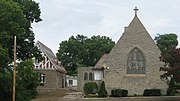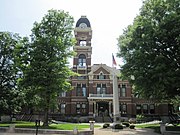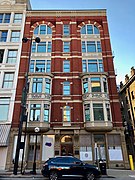| Albert Cone Nash | |
|---|---|
| Born | (1825-12-10)December 10, 1825 New York City |
| Died | June 15, 1890(1890-06-15) (aged 64) Cincinnati |
| Nationality | American |
| Occupation | Architect |

Albert C. Nash (1825-1890) was an American architect best known for his work in Milwaukee and Cincinnati.
Life and career
Albert Cone Nash was born December 10, 1825, in New York City to Burr Nash and Mary (Oatman) Nash. In 1832 the family moved to New Haven, Connecticut, where Nash was educated and was trained in architecture. The leading architects in New Haven at the time were Henry Austin and Sidney Mason Stone, but it is not documented if he worked for either. In 1848 he established himself as an architect in Bridgeport, where he practiced for eight years. In 1856 he moved west to Milwaukee. In 1867, having been awarded the commission to design the new Cincinnati Hospital, he relocated to Cincinnati. He continued to live and work in Cincinnati until his death in 1890.
The notable Connecticut architects Rufus W. Bunnell, Robert W. Hill and Edward R. Lambert all received training in Nash's office, and he was a mentor to many young Cincinnati architects.
Nash was a founding member of the Cincinnati chapter of the American Institute of Architects in 1870. He served twice as the group's president, from 1873 to 1877 and 1882 to 1885.
Personal life
Nash married in 1851 to Henrietta B. Tucker of New Haven. He had at least one son, M. R. Nash, who was also an architect and succeeded to his father's practice after his death. The younger Nash was born in Milwaukee, and began working for his father in 1879. After two years of private practice Nash formed a partnership with Lucien F. Plympton circa 1892. Nash & Plympton practiced together until at least 1895.
Albert C. Nash died July 15, 1890, at home in Walnut Hills.
Projects
- Trinity Episcopal Church, Southport, Connecticut (1854–56, destroyed and rebuilt 1862)
- Greenfield Hill Congregational Church, Fairfield, Connecticut (1855, altered)
- House for James H. Rogers, Milwaukee, Wisconsin (1856–57, demolished)
- Bank of Milwaukee Building, Milwaukee, Wisconsin (1858–59, altered 1903, NRHP 1984)
- Additions to the Wisconsin School for the Deaf, Delavan, Wisconsin (1866–67, demolished)
- "Holmesdale" for Daniel Henry Holmes, Covington, Kentucky (1866–67, demolished 1936)
- Cincinnati Hospital, Cincinnati, Ohio (1867–69, demolished)
- House for Elias Howe Jr., Bridgeport, Connecticut (circa 1867, not built)
- House for Anthony H. Hinkle, Mount Auburn, Cincinnati, Ohio (1868, demolished)
- Mound Street Temple, Cincinnati, Ohio (1868–69, demolished)
- Central Christian Church, Cincinnati, Ohio (1869–72, demolished)
- Bourbon County Courthouse, Paris, Kentucky (1873–74, burned 1901)
- First Presbyterian Church, Glendale, Ohio (1873)
- Trinity Episcopal Church, Parkersburg, West Virginia (1878–79, NRHP 1982)
- Parish hall of Grace Church (former), Cincinnati, Ohio (1880, NRHP 1982)
- Dueber Watch Case Manufacturing Company factories, Newport, Kentucky (1882–83 and 1886)
- St. Clair Hotel, Cincinnati, Ohio (1882, demolished)
- Wyoming Baptist Church, Wyoming, Ohio (1882)
- Campbell County Courthouse, Newport, Kentucky (1883–84, NRHP 1988)
- Latonia Race Track, Covington, Kentucky (1883, demolished)
- Sisters of Charity of Cincinnati motherhouse, Mount Saint Joseph, Ohio (1883)
- Masonic Building, Ludlow, Kentucky (1884)
- R. C. Church of the Assumption (former), Cincinnati, Ohio (1884–85)
- Walnut Hills Christian Church, Cincinnati, Ohio (1884, demolished)
- Hoffner Building, Cincinnati, Ohio (1885)
- Walnut Hills Baptist Church, Cincinnati, Ohio (1885, demolished)
- Fort Washington Hotel, Cincinnati, Ohio (1887)
- Westminster Presbyterian Church, Cincinnati, Ohio (1888, demolished)
- St. Nicholas Hotel annex, Cincinnati, Ohio (1890, demolished)
- Carlisle Building, Cincinnati, Ohio (no date, demolished)
Gallery of architectural works
-
 Trinity Episcopal Church, Southport, Connecticut, 1854-56.
Trinity Episcopal Church, Southport, Connecticut, 1854-56.
-
 House for James H. Rogers, Milwaukee, Wisconsin, 1856-57.
House for James H. Rogers, Milwaukee, Wisconsin, 1856-57.
-
 Bank of Milwaukee Building, Milwaukee, Wisconsin, 1858-59.
Bank of Milwaukee Building, Milwaukee, Wisconsin, 1858-59.
-
 Cincinnati Hospital, Cincinnati, Ohio, 1868-69.
Cincinnati Hospital, Cincinnati, Ohio, 1868-69.
-
 Trinity Episcopal Church, Parkersburg, West Virginia, 1878-79.
Trinity Episcopal Church, Parkersburg, West Virginia, 1878-79.
-
 Parish hall (left) of Grace Church, Cincinnati, Ohio, 1880.
Parish hall (left) of Grace Church, Cincinnati, Ohio, 1880.
-
 Campbell County Courthouse, Newport, Kentucky, 1883-84.
Campbell County Courthouse, Newport, Kentucky, 1883-84.
-
 Hoffner Building, Cincinnati, Ohio, 1885.
Hoffner Building, Cincinnati, Ohio, 1885.
-
 Fort Washington Hotel, Cincinnati, Ohio, 1887.
Fort Washington Hotel, Cincinnati, Ohio, 1887.
Notes
- This was the most expensive house in Milwaukee at the time of construction. Later owned and altered by John Plankinton.
- Annexed in 1903 to the neighboring building of the Milwaukee National Bank to designs by Ferry & Clas. The building is the only known building by Nash remaining in Milwaukee.
- The house became the Holmes High School in 1919, and was demolished for an extension to the school in 1936.
- This house was to be built on the site of P. T. Barnum's Iranistan, but Howe died before plans were completed.
- Located in the West End, which was mostly demolished in the 1950s. The building has also been attributed to Samuel Hannaford.
- A contributing property to the Glendale Historic District, listed on the National Register of Historic Places in 1976.
- The main church was built in 1869 and designed by James W. McLaughlin.
- The later and larger of these two buildings has been demolished.
- A contributing property to the Village Historic District, listed on the National Register of Historic Places in 1986.
- A contributing property to the Newport Courthouse Square Historic District, listed on the National Register of Historic Places in 2010.
- A contributing property to the Central Ludlow Historic District, listed on the National Register of Historic Places in 1984.
- A contributing property to the Hoffner Historic District, listed on the National Register of Historic Places in 1978.
References
- ^ Sylvester Nash, The Nash Family; or Records of the Descendants of Thomas Nash of New Haven, Connecticut, 1640 (Hartford: Sylvester Nash, 1853): 254.
- ^ "Death of Architect Albert C. Nash," Inland Architect and News Record 16, no. 1 (August 1890): 3.
- ^ Walter E. Langsam "Nash, Albert C. (A. C)" in Biographical Dictionary of Cincinnati Architects. 2010, accessed September 21, 2021.
- history Archived 2010-03-05 at the Wayback Machine American Institute of Architects Cincinnati
- David Sturges, Working Long Toward Grace Above, Trinity Parish's Sesquicentennial Story (2012).
- George H. Merwin, Ye Church and Parish of Greenfield (Greenfield Hill: Greenfield Hill Congregational Church, 1913)
- James Smith Buck Pioneer History of Milwaukee: 1854-1860 Volume 4 of Pioneer History of Milwaukee Publisher Milwaukee News Co., 1886 Original from the University of California Digitized Jun 7, 2007
- State Bank of Wisconsin NRHP Registration Form (1984)
- Sixteenth Annual Report of the Trustees of the Wisconsin Institute for the Education of the Deaf and Dumb for the Year Ending October, 1867 (Wisconsin: State of Wisconsin, 1867)
- ^ Campbell County Courthouse NRHP Registration Form (1988)
- "The Cincinnati Hospital," Cincinnati Lancet and Observer 12, no. 1 (January 1869): 52-57.
- "Design for the Residence of Elias Howe, Jr., Bridgeport, Ct.," Horticulturalist 25, no. 292 (October 1870): 292-293.
- "Design for the Residence of A. H. Hinkle, Cincinnati, Ohio," Horticulturalist 25, no. 293 (November 1870): 334-335.
- Glendale Historic District NRHP Registration Form (1976)
- Trinity Episcopal Church NRHP Registration Form (1982)
- Grace Church NRHP Registration Form (1982)
- Village Historic District NRHP Registration Form (1986)